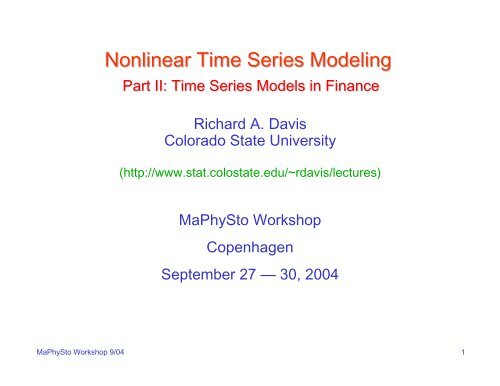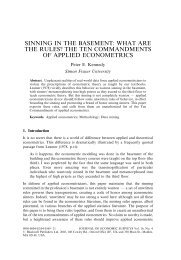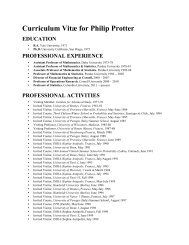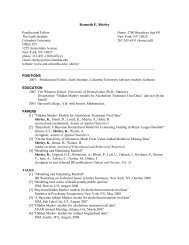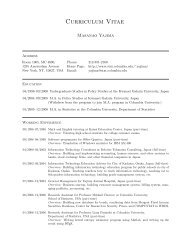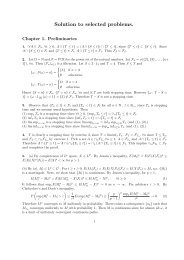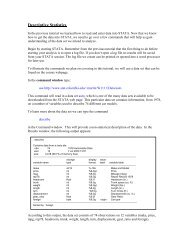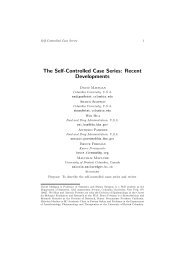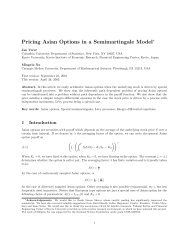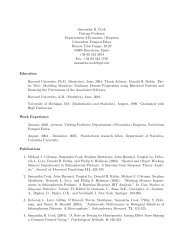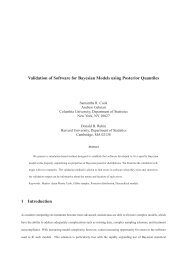Lectures for Part II: Time Series Models in Finance
Lectures for Part II: Time Series Models in Finance
Lectures for Part II: Time Series Models in Finance
Create successful ePaper yourself
Turn your PDF publications into a flip-book with our unique Google optimized e-Paper software.
Nonl<strong>in</strong>ear <strong>Time</strong> <strong>Series</strong> Model<strong>in</strong>g<br />
<strong>Part</strong> <strong>II</strong>: <strong>Time</strong> <strong>Series</strong> <strong>Models</strong> <strong>in</strong> F<strong>in</strong>ance<br />
Richard A. Davis<br />
Colorado State University<br />
(http://www.stat.colostate.edu/~rdavis/lectures)<br />
MaPhySto Workshop<br />
Copenhagen<br />
September 27 — 30, 2004<br />
MaPhySto Workshop 9/04<br />
1
<strong>Part</strong> <strong>II</strong>: <strong>Time</strong> <strong>Series</strong> <strong>Models</strong> <strong>in</strong> F<strong>in</strong>ance<br />
1. Classification of white noise<br />
2. Examples<br />
3. “Stylized facts” concern<strong>in</strong>g f<strong>in</strong>ancial time series<br />
4. ARCH and GARCH models<br />
5. Forecast<strong>in</strong>g with GARCH<br />
6. IGARCH<br />
7. Stochastic volatility models<br />
8. Regular variation and application to f<strong>in</strong>ancial TS<br />
8.1 univariate case<br />
8.2 multivariate case<br />
8.3 applications of multivariate regular variation<br />
8.4 application of multivariate RV equivalence<br />
8.5 examples<br />
8.6 Extremes <strong>for</strong> GARCH and SV models<br />
8.7 Summary of results <strong>for</strong> ACF of GARCH & SV models<br />
MaPhySto Workshop 9/04<br />
2
1. Classification of White Noise<br />
As we have already seen from f<strong>in</strong>ancial data, such as log(returns),<br />
and from residuals from some ARMA model fits, one needs to<br />
consider time series models <strong>for</strong> white noise (uncorrelated) that<br />
allows <strong>for</strong> dependence.<br />
Classification of WN (<strong>in</strong> <strong>in</strong>creas<strong>in</strong>g degree of “whiteness”).<br />
MaPhySto Workshop 9/04<br />
3
1. Classification of White Noise (cont)<br />
MaPhySto Workshop 9/04<br />
4
2. Examples<br />
(1) All-pass processs. Satisfies W1 and not W2.<br />
MaPhySto Workshop 9/04<br />
5
2. Examples (cont)<br />
MaPhySto Workshop 9/04<br />
6
2. Examples (cont)<br />
MaPhySto Workshop 9/04<br />
7
2. Examples (cont)<br />
MaPhySto Workshop 9/04<br />
8
2. Examples (cont)<br />
MaPhySto Workshop 9/04<br />
9
2. Examples (cont)<br />
MaPhySto Workshop 9/04<br />
10
2. Examples (cont)<br />
MaPhySto Workshop 9/04<br />
11
2. Examples (cont)<br />
Properties of ARCH(1) process:<br />
1. Strictly stationary solution if 0 < α 1
2. Examples (cont)<br />
Likelihood function:<br />
MaPhySto Workshop 9/04<br />
13
2. Examples (cont)<br />
A realization of the process<br />
MaPhySto Workshop 9/04<br />
14
2. Examples (cont)<br />
The sample ACF.<br />
MaPhySto Workshop 9/04<br />
15
2. Examples (cont)<br />
The sample ACF of the absolute values and squares.<br />
MaPhySto Workshop 9/04<br />
16
MaPhySto Workshop 9/04<br />
17
3. “Stylized Facts” of F<strong>in</strong>ancial Returns<br />
Def<strong>in</strong>e X t = 100*(ln (P t ) - ln (P t-1 )) (log returns)<br />
• heavy tailed<br />
P(|X 1 | > x) ~ C x -α , 0 < α < 4.<br />
• uncorrelated<br />
ˆ<br />
ρ X<br />
( h)<br />
near 0 <strong>for</strong> all lags h > 0 (MGD sequence?)<br />
• |X t | and X t2 have slowly decay<strong>in</strong>g autocorrelations<br />
ρˆ ( ) and ˆ<br />
| X |<br />
h ρ 2 ( h)<br />
• process exhibits ‘stochastic volatility’.<br />
X<br />
converge to 0 slowly as h <strong>in</strong>creases.<br />
MaPhySto Workshop 9/04<br />
18
Log returns <strong>for</strong> IBM 1/3/62-11/3/00 (blue=1961-1981)<br />
100*log(returns)<br />
-20 -10 0 10<br />
MaPhySto Workshop 9/04<br />
1962 1967 1972 1977 1982 1987 1992 1997<br />
time<br />
19
Sample ACF IBM (a) 1962-1981, (b) 1982-2000<br />
(a) ACF of IBM (1st half)<br />
(b) ACF of IBM (2nd half)<br />
ACF<br />
0.0 0.2 0.4 0.6 0.8 1.0<br />
ACF<br />
0.0 0.2 0.4 0.6 0.8 1.0<br />
0 10 20 30 40<br />
Lag<br />
0 10 20 30 40<br />
Lag<br />
Remark: Both halves look like white noise.<br />
MaPhySto Workshop 9/04<br />
20
ACF of squares <strong>for</strong> IBM (a) 1961-1981, (b) 1982-2000<br />
(a) ACF, Squares of IBM (1st half)<br />
(b) ACF, Squares of IBM (2nd half)<br />
ACF<br />
0.0 0.2 0.4 0.6 0.8 1.0<br />
ACF<br />
0.0 0.2 0.4 0.6 0.8 1.0<br />
0 10 20 30 40<br />
0 10 20 30 40<br />
Lag<br />
Lag<br />
Remark: <strong>Series</strong> are not <strong>in</strong>dependent white noise?<br />
MaPhySto Workshop 9/04<br />
21
Plot of M t (4)/S t (4) <strong>for</strong> IBM<br />
M(4)/S(4)<br />
0.0 0.2 0.4 0.6 0.8 1.0<br />
MaPhySto Workshop 9/04<br />
0 2000 4000 6000 8000 10000<br />
Remark: For <strong>II</strong>D data, M t (k)/S t (k) → 0 as t →∞iff E|X , | k < ∞, where<br />
t<br />
k<br />
k<br />
M<br />
t<br />
= maxs= 1,...,<br />
t<br />
| X<br />
s<br />
| and St<br />
= ∑|<br />
X<br />
s<br />
|<br />
t<br />
s=<br />
1<br />
22
Hill’s estimator of tail <strong>in</strong>dex<br />
The marg<strong>in</strong>al distribution F <strong>for</strong> heavy-tailed data is often modeled us<strong>in</strong>g<br />
Pareto-like tails,<br />
1-F(x) = x -α L(x),<br />
<strong>for</strong> x large, where L(x) is a slowly vary<strong>in</strong>g function (L(xt)/ L(x)→1, as x<br />
→∞). Now if<br />
X~ F, then P(log X > x) = P(X > exp(x))=exp(-αx)L(exp(x)),<br />
and hence log X has an approximate exponential distribution <strong>for</strong> large x.<br />
The spac<strong>in</strong>gs,<br />
log( X (j) ) − log(X (j+1) ) , j=1,2,. . . ,m,<br />
from a sample of size n from an exponential distr are approximately<br />
<strong>in</strong>dependent and Exp(αj) distributed. This suggests estimat<strong>in</strong>g α −1 by<br />
MaPhySto Workshop 9/04<br />
αˆ<br />
−1<br />
=<br />
=<br />
1<br />
m<br />
1<br />
m<br />
m<br />
∑( log X<br />
( j)<br />
− log X<br />
( j+<br />
1)<br />
)<br />
j=<br />
1<br />
m<br />
∑( log X<br />
( j)<br />
− log X<br />
( m+<br />
1)<br />
)<br />
j=<br />
1<br />
j<br />
23
Hill’s estimator of tail <strong>in</strong>dex<br />
Def: The Hill estimate of α <strong>for</strong> heavy-tailed data with distribution given<br />
by<br />
1-F(x) = x -α L(x),<br />
is<br />
αˆ<br />
−1<br />
=<br />
1<br />
m<br />
m<br />
∑( log X<br />
( j)<br />
− log X<br />
( j+<br />
1)<br />
)<br />
j=<br />
1<br />
j<br />
=<br />
1<br />
m<br />
m<br />
∑( log X<br />
( j)<br />
− log X<br />
( m+<br />
1)<br />
)<br />
j=<br />
1<br />
The asymptotic variance of this estimate <strong>for</strong> α is<br />
ˆ 2<br />
2<br />
α / m and estimated by α / m.<br />
(See also GPD=generalized Pareto distribution.)<br />
MaPhySto Workshop 9/04<br />
24
Hill’s plot of tail <strong>in</strong>dex <strong>for</strong> IBM (1962-1981, 1982-2000)<br />
Hill<br />
1 2 3 4 5<br />
Hill<br />
1 2 3 4 5<br />
0 200 400 600 800 1000<br />
m<br />
0 200 400 600 800<br />
m<br />
MaPhySto Workshop 9/04<br />
25
4. ARCH and GARCH <strong>Models</strong><br />
MaPhySto Workshop 9/04<br />
26
4. ARCH and GARCH <strong>Models</strong> (cont)<br />
MaPhySto Workshop 9/04<br />
27
4. ARCH and GARCH <strong>Models</strong> (cont)<br />
MaPhySto Workshop 9/04<br />
28
4. ARCH and GARCH <strong>Models</strong> (cont)<br />
MaPhySto Workshop 9/04<br />
29
4. ARCH and GARCH <strong>Models</strong> (cont)<br />
MaPhySto Workshop 9/04<br />
30
4. ARCH and GARCH <strong>Models</strong> (cont)<br />
MaPhySto Workshop 9/04<br />
31
4. ARCH and GARCH <strong>Models</strong> (cont)<br />
MaPhySto Workshop 9/04<br />
32
4. ARCH and GARCH <strong>Models</strong> (cont)<br />
MaPhySto Workshop 9/04<br />
33
4. ARCH and GARCH <strong>Models</strong> (cont)<br />
MaPhySto Workshop 9/04<br />
34
4. ARCH and GARCH <strong>Models</strong> (cont)<br />
MaPhySto Workshop 9/04<br />
35
4. ARCH and GARCH <strong>Models</strong> (cont)<br />
MaPhySto Workshop 9/04<br />
36
4. ARCH and GARCH <strong>Models</strong> (cont)<br />
i<br />
MaPhySto Workshop 9/04<br />
37
4. ARCH and GARCH <strong>Models</strong> (cont)<br />
MaPhySto Workshop 9/04<br />
38
MaPhySto Workshop 9/04<br />
39
4. ARCH and GARCH <strong>Models</strong> (cont)<br />
MaPhySto Workshop 9/04<br />
40
4. ARCH and GARCH <strong>Models</strong> (cont)<br />
SS but not WS GARCH Processes<br />
MaPhySto Workshop 9/04<br />
41
4. ARCH and GARCH <strong>Models</strong> (cont)<br />
MaPhySto Workshop 9/04<br />
42
MaPhySto Workshop 9/04<br />
43
4. ARCH and GARCH <strong>Models</strong> (cont)<br />
MaPhySto Workshop 9/04<br />
44
4. ARCH and GARCH <strong>Models</strong> (cont)<br />
MaPhySto Workshop 9/04<br />
45
MaPhySto Workshop 9/04<br />
46
MaPhySto Workshop 9/04<br />
47
MaPhySto Workshop 9/04<br />
48
Parameter Estimation <strong>for</strong> F<strong>in</strong>ite-Variance GARCH <strong>Models</strong><br />
MaPhySto Workshop 9/04<br />
49
4. ARCH and GARCH <strong>Models</strong> (cont)<br />
MaPhySto Workshop 9/04<br />
50
MaPhySto Workshop 9/04<br />
51
MaPhySto Workshop 9/04<br />
52
4. ARCH and GARCH <strong>Models</strong> (cont)<br />
MaPhySto Workshop 9/04<br />
53
4. ARCH and GARCH <strong>Models</strong> (cont)<br />
MaPhySto Workshop 9/04<br />
54
4. ARCH and GARCH <strong>Models</strong> (cont)<br />
MaPhySto Workshop 9/04<br />
55
4. ARCH and GARCH <strong>Models</strong> (cont)<br />
MaPhySto Workshop 9/04<br />
56
4. ARCH and GARCH <strong>Models</strong> (cont)<br />
MaPhySto Workshop 9/04<br />
57
4. ARCH and GARCH <strong>Models</strong> (cont)<br />
MaPhySto Workshop 9/04<br />
58
4. ARCH and GARCH <strong>Models</strong> (cont)<br />
MaPhySto Workshop 9/04<br />
59
4. ARCH and GARCH <strong>Models</strong> (cont)<br />
MaPhySto Workshop 9/04<br />
60
4. ARCH and GARCH <strong>Models</strong> (cont)<br />
MaPhySto Workshop 9/04<br />
61
4. ARCH and GARCH <strong>Models</strong> (cont)<br />
MaPhySto Workshop 9/04<br />
62
MaPhySto Workshop 9/04<br />
63
4. ARCH and GARCH <strong>Models</strong> (cont)<br />
MaPhySto Workshop 9/04<br />
64
4. ARCH and GARCH <strong>Models</strong> (cont)<br />
MaPhySto Workshop 9/04<br />
65
5. Forecast<strong>in</strong>g with GARCH<br />
MaPhySto Workshop 9/04<br />
66
5. Forecast<strong>in</strong>g with GARCH (cont)<br />
MaPhySto Workshop 9/04<br />
67
6. IGARCH<br />
MaPhySto Workshop 9/04<br />
68
7. Stochastic Volatility <strong>Models</strong><br />
MaPhySto Workshop 9/04<br />
69
7. Stochastic Volatility <strong>Models</strong> (cont)<br />
MaPhySto Workshop 9/04<br />
70
7. Stochastic Volatility <strong>Models</strong> (cont)<br />
MaPhySto Workshop 9/04<br />
71
7. Stochastic Volatility <strong>Models</strong> (cont)<br />
MaPhySto Workshop 9/04<br />
72
7. Stochastic Volatility <strong>Models</strong> (cont)<br />
MaPhySto Workshop 9/04<br />
73
7. Stochastic Volatility <strong>Models</strong> (cont)<br />
MaPhySto Workshop 9/04<br />
74
7. Stochastic Volatility <strong>Models</strong> (cont)<br />
MaPhySto Workshop 9/04<br />
75
7. Stochastic Volatility <strong>Models</strong> (cont)<br />
MaPhySto Workshop 9/04<br />
76
7. Stochastic Volatility <strong>Models</strong> (cont)<br />
MaPhySto Workshop 9/04<br />
77
7. Stochastic Volatility <strong>Models</strong> (cont)<br />
MaPhySto Workshop 9/04<br />
78
7. Stochastic Volatility <strong>Models</strong> (cont)<br />
MaPhySto Workshop 9/04<br />
79
7. Stochastic Volatility <strong>Models</strong> (cont)<br />
MaPhySto Workshop 9/04<br />
80
MaPhySto Workshop 9/04<br />
81
7. Stochastic Volatility <strong>Models</strong> (cont)<br />
MaPhySto Workshop 9/04<br />
82
8. Regular variation and application to f<strong>in</strong>ancial TS models<br />
8.1 Regular variation — univariate case<br />
Def: The random variable X is regularly vary<strong>in</strong>g with <strong>in</strong>dex α if<br />
P(|X|> t x)/P(|X|>t) → x −α and P(X> t)/P(|X|>t) →p,<br />
or, equivalently, if<br />
P(X> t x)/P(|X|>t) → px −α and P(X< −t x)/P(|X|>t) → qx −α ,<br />
where 0 ≤ p ≤ 1 and p+q=1.<br />
Equivalence:<br />
X is RV(α) if and only if P(X ∈ t • ) /P(|X|>t)→ v µ(• )<br />
(→ v vague convergence of measures on R\{0}). In this case,<br />
µ(dx) = (pα x −α−1 I(x>0) + qα (-x) -α−1 I(x
8.1 Regular variation — univariate case (cont)<br />
Another <strong>for</strong>mulation (polar coord<strong>in</strong>ates):<br />
Def<strong>in</strong>e the ± 1 valued rv θ, P(θ = 1) = p, P(θ = −1) = 1− p = q.<br />
Then<br />
X is RV(α) if and only if<br />
or<br />
P(|<br />
X | t x, X/ | X | ∈ S)<br />
→<br />
P(|<br />
X | > t )<br />
> −α<br />
x<br />
P(<br />
θ∈<br />
S)<br />
P(|<br />
X| t x,X/| X| ∈• )<br />
→<br />
P(|<br />
X| > t )<br />
> −α<br />
v<br />
x<br />
P(<br />
θ∈•<br />
)<br />
(→ v vague convergence of measures on S 0 = {-1,1}).<br />
MaPhySto Workshop 9/04<br />
84
8.2 Regular variation — multivariate case<br />
Multivariate regular variation of X=(X 1 , . . . , X m ): There exists a<br />
random vector θ ∈ S m-1 such that<br />
Equivalence:<br />
P(|X|> t x, X/|X| ∈ •)/P(|X|>t) → v x −α P( θ ∈•)<br />
(→ v vague convergence on S m-1 , unit sphere <strong>in</strong> R m ) .<br />
• P( θ ∈•) is called the spectral measure<br />
• α is the <strong>in</strong>dex of X.<br />
P(<br />
X<br />
∈t<br />
•)<br />
→ v<br />
µ (<br />
•<br />
)<br />
P<br />
(|<br />
X<br />
| ><br />
t )<br />
µ is a measure on R m which satisfies <strong>for</strong> x > 0 and A bounded away<br />
from 0,<br />
µ(xB) = x −α µ(xA).<br />
MaPhySto Workshop 9/04<br />
85
8.2 Regular variation — multivariate case (cont)<br />
Examples:<br />
1. If X 1 > 0 and X 2 > 0 are iid RV(α), then X= (X 1 , X 2 ) is<br />
multivariate regularly vary<strong>in</strong>g with <strong>in</strong>dex α and spectral distribution<br />
P( θ =(0,1) ) = P( θ =(1,0) ) =.5 (mass on axes).<br />
Interpretation: Unlikely that X 1 and X 2 are very large at the same<br />
time.<br />
Figure: plot of<br />
(X t1 ,X t2 ) <strong>for</strong> realization<br />
of 10,000.<br />
x_2<br />
0 10 20 30 40<br />
MaPhySto Workshop 9/04<br />
0 5 10 15 20<br />
x_1<br />
86
2. If X 1 = X 2 > 0, then X= (X 1 , X 2 ) is multivariate regularly vary<strong>in</strong>g<br />
with <strong>in</strong>dex α and spectral distribution<br />
P( θ = (1/√2, 1/√2) ) = 1.<br />
3. AR(1): X t = .9 X t-1 + Z t , {Z t }~<strong>II</strong>D symmetric stable (1.8)<br />
{<br />
±(1,.9)/sqrt(1.81), W.P. .9898<br />
Distr of θ:<br />
±(0,1), W.P. .0102<br />
Figure: plot of (X t ,<br />
X t+1 ) <strong>for</strong> realization<br />
of 10,000.<br />
x_{t+1}<br />
-10 0 10 20 30<br />
MaPhySto Workshop 9/04<br />
-10 0 10 20 30<br />
x_t<br />
87
8.3 Applications of multivariate regular variation<br />
• Doma<strong>in</strong> of attraction <strong>for</strong> sums of iid random vectors<br />
(Rvaceva, 1962). That is, when does the partial sum<br />
−1<br />
a n<br />
∑<br />
t=<br />
1<br />
converge <strong>for</strong> some constants a n ?<br />
n<br />
• Spectral measure of multivariate stable vectors.<br />
• Doma<strong>in</strong> of attraction <strong>for</strong> componentwise maxima of iid<br />
random vectors (Resnick, 1987). Limit behavior of<br />
1<br />
a −<br />
n<br />
n<br />
∨<br />
t=<br />
1<br />
• Weak convergence of po<strong>in</strong>t processes with iid po<strong>in</strong>ts.<br />
• Solution to stochastic recurrence equations, Y t = A t Y t-1 + B t<br />
• Weak convergence of sample autocovariances.<br />
X<br />
t<br />
X<br />
t<br />
MaPhySto Workshop 9/04<br />
88
8.3 Applications of multivariate regular variation (cont)<br />
L<strong>in</strong>ear comb<strong>in</strong>ations:<br />
X ~RV(α) ⇒ all l<strong>in</strong>ear comb<strong>in</strong>ations of X are regularly vary<strong>in</strong>g<br />
i.e., there exist α and slowly vary<strong>in</strong>g fcn L(.), s.t.<br />
P(c T X> t)/(t -α L(t)) →w(c), exists <strong>for</strong> all real-valued c,<br />
where<br />
w(tc) = t −α w(c).<br />
Use vague convergence with A c ={y: c T y > 1}, i.e.,<br />
T<br />
P(<br />
X<br />
∈<br />
tA<br />
c<br />
)<br />
P<br />
( c<br />
X<br />
> t)<br />
=<br />
→µ (A )<br />
:<br />
w(<br />
),<br />
c<br />
= c<br />
−α<br />
t L<br />
(<br />
t)<br />
P(|<br />
X<br />
|<br />
><br />
t )<br />
A c<br />
where t -α L(t) = P(|X| > t).<br />
MaPhySto Workshop 9/04<br />
89
8.3 Applications of multivariate regular variation (cont)<br />
Converse?<br />
X ~RV(α) ⇐ all l<strong>in</strong>ear comb<strong>in</strong>ations of X are regularly vary<strong>in</strong>g?<br />
There exist α and slowly vary<strong>in</strong>g fcn L(.), s.t.<br />
(LC) P(c T X> t)/(t -α L(t)) →w(c), exists <strong>for</strong> all real-valued c.<br />
Theorem (Basrak, Davis, Mikosch, `02). Let X be a random vector.<br />
1. If X satisfies (LC) with α non-<strong>in</strong>teger, then X is RV(α).<br />
2. If X > 0 satisfies (LC) <strong>for</strong> non-negative c and α is non-<strong>in</strong>teger,<br />
then X is RV(α).<br />
3. If X > 0 satisfies (LC) with α an odd <strong>in</strong>teger, then X is RV(α).<br />
MaPhySto Workshop 9/04<br />
90
8.4 Applications of theorem<br />
1. Kesten (1973). Under general conditions, (LC) holds with L(t)=1<br />
<strong>for</strong> stochastic recurrence equations of the <strong>for</strong>m<br />
Y t = A t Y t-1 + B t ,<br />
(A t , B t ) ~ <strong>II</strong>D,<br />
A t d×d random matrices, B t random d-vectors.<br />
It follows that the distributions of Y t , and <strong>in</strong> fact all of the f<strong>in</strong>ite dim’l<br />
distrs of Y t are regularly vary<strong>in</strong>g (if α is non-even).<br />
2. GARCH processes. S<strong>in</strong>ce squares of a GARCH process can be<br />
embedded <strong>in</strong> a SRE, the f<strong>in</strong>ite dimensional distributions of a<br />
GARCH are regularly vary<strong>in</strong>g.<br />
MaPhySto Workshop 9/04<br />
91
8.5 Examples<br />
Example of ARCH(1): X t =(α 0 +α 1 X 2 t-1) 1/2 Z t ,<br />
{Z t }~<strong>II</strong>D.<br />
α found by solv<strong>in</strong>g E|α 1 Z 2 | α/2 = 1.<br />
α 1 .312 .577 1.00 1.57<br />
α 8.00 4.00 2.00 1.00<br />
Distr of θ:<br />
P(θ ∈•) = E{||(B,Z)|| α I(arg((B,Z)) ∈ •)}/ E||(B,Z)|| α<br />
where<br />
P(B = 1) = P(B = -1) =.5<br />
MaPhySto Workshop 9/04<br />
92
8.4 Examples (cont)<br />
Example of ARCH(1): α 0 =1, α 1 =1, α=2, X t =(α 0 +α 1 X 2 t-1) 1/2 Z t ,<br />
{Z t }~<strong>II</strong>D<br />
Figures: plots of (X t , X t+1 ) and estimated distribution of θ <strong>for</strong><br />
realization of 10,000.<br />
x_{t+1}<br />
-20 -10 0 10 20<br />
-20 -10 0 10 20<br />
x_t<br />
0.06 0.08 0.10 0.12 0.14 0.16 0.18<br />
-3 -2 -1 0 1 2 3<br />
theta<br />
MaPhySto Workshop 9/04<br />
93
8.4 Applications of theorem (cont)<br />
Example: SV model X t = σ t Z t<br />
Suppose Z t ~ RV(α) and<br />
logσ<br />
2<br />
t<br />
=<br />
∞<br />
∑<br />
j=−∞<br />
ψ ε<br />
j<br />
t−<br />
j<br />
,<br />
∞<br />
∑<br />
j=−∞<br />
ψ<br />
2<br />
j<br />
< ∞,{<br />
ε<br />
t<br />
}~ <strong>II</strong>DN(0, σ<br />
2<br />
).<br />
Then Z n =(Z 1 ,…,Z n )’ is regulary vary<strong>in</strong>g with <strong>in</strong>dex α and so is<br />
X n = (X 1 ,…,X n )’ = diag(σ 1 ,…, σ n ) Z n<br />
with spectral distribution concentrated on (±1,0), (0, ±1).<br />
Figure: plot of<br />
(X t ,X t+1 ) <strong>for</strong><br />
realization of 10,000.<br />
x_2<br />
-5000 0 5000 10000<br />
MaPhySto Workshop 9/04<br />
-5000 0 5000 10000<br />
x_1<br />
94
8.6 Extremes <strong>for</strong> GARCH and SV processes<br />
Setup<br />
• X t = σ t Z t , {Z t } ~ <strong>II</strong>D (0,1)<br />
• X t is RV (α)<br />
• Choose {b n } s.t. nP(X t > b n ) →1<br />
Then<br />
P<br />
n −<br />
( 1 −<br />
b X1<br />
≤ x)<br />
→exp{<br />
−x<br />
α<br />
n<br />
}.<br />
Then, with M n = max{X 1 , . . . , X n },<br />
(i) GARCH:<br />
P(<br />
b<br />
MaPhySto Workshop 9/04<br />
γ is extremal <strong>in</strong>dex ( 0 < γ < 1).<br />
(ii) SV model:<br />
P(<br />
b<br />
M<br />
≤ x)<br />
→exp{<br />
−γx<br />
−1 −α<br />
n n<br />
M<br />
≤ x)<br />
→ exp{ −x<br />
},<br />
−1 −α<br />
n n<br />
},<br />
extremal <strong>in</strong>dex γ = 1 no cluster<strong>in</strong>g.<br />
95
8.6 Extremes <strong>for</strong> GARCH and SV processes (cont)<br />
(i) GARCH:<br />
P(<br />
b<br />
(ii) SV model: P(<br />
b<br />
M<br />
≤ x)<br />
→ exp{ −γx<br />
−1 −α<br />
n n<br />
M<br />
≤ x)<br />
→exp{<br />
−x<br />
−1 −α<br />
n n<br />
}<br />
}<br />
Remarks about extremal <strong>in</strong>dex.<br />
(i)<br />
(ii)<br />
γ < 1 implies cluster<strong>in</strong>g of exceedances<br />
Numerical example. Suppose c is a threshold such that<br />
Then, if γ = .5, P(<br />
b<br />
(iii) 1/γ is the mean cluster size of exceedances.<br />
(iv) Use γ to discrim<strong>in</strong>ate between GARCH and SV models.<br />
(v)<br />
P<br />
n −1<br />
( bn<br />
X1<br />
−1<br />
n<br />
M<br />
n<br />
≤ c)<br />
~ .95<br />
≤ c)<br />
~ (.95)<br />
= .975<br />
Even <strong>for</strong> the light-tailed SV model (i.e., {Z t } ~<strong>II</strong>D N(0,1), the<br />
extremal <strong>in</strong>dex is 1 (see Breidt and Davis `98 )<br />
.5<br />
MaPhySto Workshop 9/04<br />
96
8.6 Extremes <strong>for</strong> GARCH and SV processes (cont)<br />
0 10 20 30<br />
** * * *** ***<br />
0 20 40 60<br />
time<br />
MaPhySto Workshop 9/04<br />
97
8.7 Summary of results <strong>for</strong> ACF of GARCH(p,q) and SV models<br />
GARCH(p,q)<br />
α∈(0,2):<br />
α∈(2,4):<br />
α∈(4,∞):<br />
d<br />
( ρˆ<br />
X<br />
( h))<br />
h= , K , m<br />
⎯⎯→(<br />
Vh<br />
/ V0<br />
)<br />
h=<br />
1, K,<br />
1 m<br />
1−2/<br />
α<br />
d −1<br />
( n ρ ( h)<br />
) ⎯⎯→ γ (0)( V ) .<br />
ˆ<br />
X h=<br />
1, K , m<br />
X h h=<br />
1, K,<br />
m<br />
1/2<br />
d −1<br />
( n ρ ( h)<br />
) ⎯⎯→<br />
(0)( G ) .<br />
ˆ<br />
X<br />
γ<br />
h= 1, K , m<br />
X h h=<br />
1, K,<br />
m<br />
,<br />
Remark: Similar results hold <strong>for</strong> the sample ACF based on |X t | and<br />
X t2 .<br />
MaPhySto Workshop 9/04<br />
98
8.7 Summary of results <strong>for</strong> ACF of GARCH(p,q) and SV models (cont)<br />
SV Model<br />
α∈(0,2):<br />
1/ α<br />
d 1 h+<br />
1 α h<br />
( n / ln n) ρˆ<br />
( h)<br />
⎯⎯→<br />
.<br />
X<br />
σ σ<br />
σ<br />
1<br />
2<br />
α<br />
S<br />
S<br />
0<br />
α∈(2, ∞):<br />
1/2<br />
d −1<br />
( n ρ ( h)<br />
) ⎯⎯→<br />
(0)( G ) .<br />
ˆ<br />
X<br />
γ<br />
h= 1, K , m<br />
X h h=<br />
1, K,<br />
m<br />
MaPhySto Workshop 9/04<br />
99
Sample ACF <strong>for</strong> GARCH and SV <strong>Models</strong> (1000 reps)<br />
(a) GARCH(1,1) Model, n=10000<br />
-0.3 -0.1 0.1 0.3<br />
(b) SV Model, n=10000<br />
-0.06 -0.02 0.02<br />
MaPhySto Workshop 9/04<br />
100
Sample ACF <strong>for</strong> Squares of GARCH (1000 reps)<br />
(a) GARCH(1,1) Model, n=10000<br />
0.0 0.2 0.4 0.6<br />
b) GARCH(1,1) Model, n=100000<br />
0.0 0.2 0.4 0.6<br />
MaPhySto Workshop 9/04<br />
101
Sample ACF <strong>for</strong> Squares of SV (1000 reps)<br />
(c) SV Model, n=10000<br />
0.0 0.01 0.02 0.03 0.04<br />
0.0 0.05 0.10 0.15<br />
(d) SV Model, n=100000<br />
MaPhySto Workshop 9/04<br />
102
Example: Amazon returns May 16, 1997 to June 16, 2004.<br />
.40<br />
<strong>Series</strong><br />
.20<br />
.00<br />
-.20<br />
-.40<br />
-.60<br />
-.80<br />
-1.00<br />
1.00<br />
0 400 800 1200 1600<br />
Residual ACF: Abs values<br />
Residual ACF: Squares<br />
1.00<br />
.80<br />
.80<br />
.60<br />
.60<br />
.40<br />
.40<br />
.20<br />
.20<br />
.00<br />
.00<br />
-.20<br />
-.20<br />
-.40<br />
-.40<br />
-.60<br />
-.60<br />
-.80<br />
-.80<br />
-1.00<br />
MaPhySto Workshop 9/04<br />
0 5 10 15 20 25 30 35 40<br />
-1.00<br />
0 5 10 15 20 25 30 35 40<br />
103
Wrap-up<br />
• Regular variation is a flexible tool <strong>for</strong> model<strong>in</strong>g both dependence<br />
and tail heav<strong>in</strong>ess.<br />
• Useful <strong>for</strong> establish<strong>in</strong>g po<strong>in</strong>t process convergence of heavy-tailed<br />
time series.<br />
• Extremal <strong>in</strong>dex γ < 1 <strong>for</strong> GARCH and γ =1<strong>for</strong> SV.<br />
Unresolved issues related to RV⇔ (LC)<br />
• α = 2n?<br />
• there is an example <strong>for</strong> which X 1 , X 2 > 0, and (c, X 1 ) and (c, X 2 )<br />
have the same limits <strong>for</strong> all c > 0.<br />
• α = 2n−1 and X > 0 (not true <strong>in</strong> general).<br />
MaPhySto Workshop 9/04<br />
104


